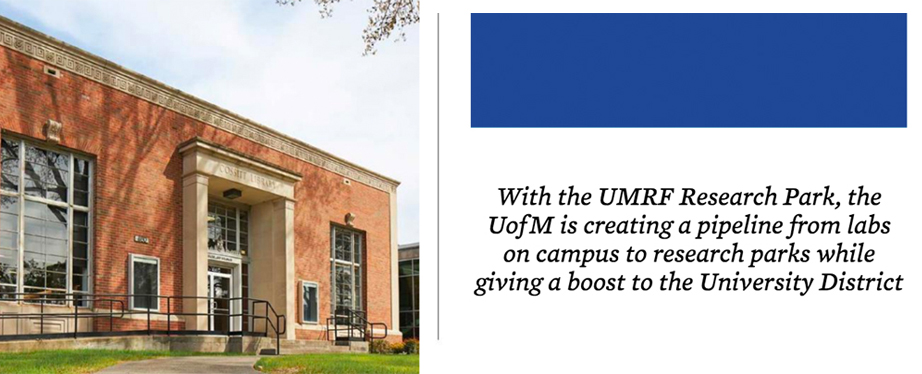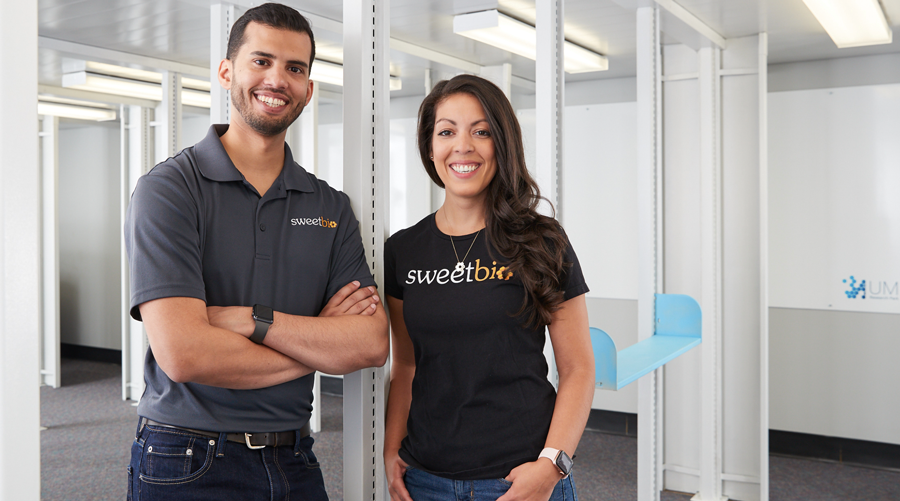By Anita Houk
Just there, at 460 S. Highland, inside the humble, red brick building that housed Memphis’s first branch library from 1951 to 2011, you can witness visionary plans unfolding.
Want to go in? It’s a two-story, approximately 10,000-sq. ft. space. A good-natured game of table tennis is being played in the loft by a couple of guys taking a break from taxing their brains.

Despite the cool-looking, open environment, there’s an unmistakable crackle of hot ideas cooking in this Phase 1 facility for the University of Memphis Research Foundation (UMRF) Research Park. Folks in the offices and community spaces have big plans, as do those considering the surrounding community.
“Dr. (M. David) Rudd has worked very hard at getting the character of the University District going,” says Dr. Jasbir Dhaliwal, UofM executive vice president for Research and Innovation. “Restaurants. Shops. Making it a happening neighborhood.”
Attract young people. Mature people. Students. Professionals. New companies. Talent, global in orientation. Lay the ground work for cutting-edge research to find a home.
“What character should the district have? Let’s put a research park there, growth companies and innovators in the middle of it all and let that define that neighborhood,” says Dhaliwal.
But let’s not lose our sense of place, he insists. Like the rehabbed Highland Branch Library, the neighborhood can flourish.
“We’re trying to help the community find its character,” explains Dhaliwal.
“We’re trying to create an ecosystem of innovation around the University. That’s very special, because in the old days, universities were like ivory towers: the philosophers cut off from the real world.
“Modern universities,” he says, “have a responsibility to contribute to the economic development of the neighborhood.”
Their game of table tennis interrupted, competitor Troy Parkes, who is in innovation development, asks his rival to grab the end of the table, and — voila — the surface converts to a conference table. Look around, and whiteboards line the walls, poised for sudden brainstorms.
Parkes also points to just inside the Highland Street entrance to a conference table he says was used by former University presidents. “It’s a great piece of history,” he says, adding that neighborhood groups are still invited to use the facility. “We combine the past with the future here.”
 A huge artwork by Memphis muralist Michael Roy emerges from a two-story wall near
the stairs. The artist, a Mississippi native better known as Birdcap, created a strange
interpretation of the god of fire, volcanoes, metalworking, stone masonry, sculpture
and craftsmen. Usually bearded, ugly and lame, the god called Vulcan in Roman mythology
is presented here in stunning blue, looking far from human and named in the Greek,
Hephaestus.
A huge artwork by Memphis muralist Michael Roy emerges from a two-story wall near
the stairs. The artist, a Mississippi native better known as Birdcap, created a strange
interpretation of the god of fire, volcanoes, metalworking, stone masonry, sculpture
and craftsmen. Usually bearded, ugly and lame, the god called Vulcan in Roman mythology
is presented here in stunning blue, looking far from human and named in the Greek,
Hephaestus.
Such are the curious counterpoints in Phase 1 of 3 for UMRF Research Park’s brave new world of innovation.
UMRF Phase 2 involves repurposing the old Defense Contract Audit Institute building at 4075 Park Ave., near Goodlett.
“It’s going to come alive with start-up companies that our students launch; companies that will come and work with our faculty members and students,” Dhaliwal says. “At the same time, the focus there will be companies that are launched based on our patents.
“When good technologies pop out of our research, we patent it. Once the patent is issued to us, the University, including the individuals involved, then the University sets up start-up ventures around the intellectual property. Currently, the University is on track to getting about 10 patents every year.”
Case in point: SweetBio, lodged on the second floor of the Highland site.
A Memphis-based startup, SweetBio specializes in using biodegradable Manuka honey from Australia and New Zealand in soft tissue or wound repair. Dr. Gary Bowlin, Herff Chair of Excellence in Biomedical Engineering, and then-postdoctoral fellow in biomedical engineering Isaac Rodriguez co-invented applications.
“SweetBio has had a very positive and collaborative relationship with the University since our incorporation in 2015,” says Rodriguez, SweetBio co-founder and chief science officer.

“When we were first approached by UMRF about SweetBio being an anchor tenant, we immediately jumped at the opportunity. It is really exciting to see the University open its doors to growth-stage startups and be proactive in facilitating collaboration with faculty for research or students for internships.”
SweetBio execs include COO Axel Strombergsson, CFO Kevin Graff and Rodriguez’s sister, Kayla Rodriguez Graff.
“Starting a company with my sister,” Rodriguez says, “was one of the coolest experiences. With her background in business, my background in science, and our trust in one another, we knew we had a powerful founding team.
“Four years ago, I would have never imagined that my idea could be the seed that planted the growth of our company.”
Updated information for SweetBio:
SweetBio received clearance from the Food and Drug Administration (FDA) on May 31 to begin selling its Apis device, a product designed to assist in the management of traumatic wounds, burns, ulcers and surgical sites. ZeroTo510, a Memphis-based startup accelerator, helped SweetBio navigate the essential, and often tricky, steps to attaining FDA approval."This is a big milestone for SweetBio as we are now allowed to market our product and help heal patients across the nation," Rodriguez said. "Our next steps are to partner with hospitals and physicians to get early usage of our product, which will provide us with the clinical evidence as we prepare for a national launch.
"As a co-inventor of the technology, it’s especially exciting because Apis was born out of the Biomedical Engineering Department at the University of Memphis with the dream that we can invent a technology that can improve the lives of our loved ones. The University has been an incredible partner in bringing our dream to a reality, and we hope that this is just the beginning of commercializing products that are developed at the University."
“As for our patients, who will ultimately benefit from our product, we are motivated every day, because we are dedicating our time to commercializing a product that is going to help our loved ones heal.”
“To create an ecosystem of innovation, we need many different players to come and interact — faculty and students and entrepreneurs and companies that want to work in research from everywhere in the world,” says Dhaliwal. “It helps shape the research agenda to be more relevant to our community and our region.”
The challenge is complex. Even as Phase 1 and 2 are getting off the ground, plans are underway for UMRF Phase 3. The latter will involve new construction, a three-story building in the Highland-Patterson area, with two floors devoted to research labs and companies that co-locate with the UofM and a third floor for student residences.
 “As the research comes out of the labs on campus, we are creating a pipeline to the
research parks,” Dhaliwal says. “We are going to have many phases. The wrong approach
is to build a huge research park and then hope ‘they’ will come. We don’t take the
high-risk approach.”
“As the research comes out of the labs on campus, we are creating a pipeline to the
research parks,” Dhaliwal says. “We are going to have many phases. The wrong approach
is to build a huge research park and then hope ‘they’ will come. We don’t take the
high-risk approach.”
Of course, without students at the core, the UMRF strategic plan could go nowhere.
“Students are central to everything a university does,” Dhaliwal says. “Today, in a full employment economy where workforce and talent are very hard to get, we are inviting companies to see our best and brightest and to co-locate with us (in Memphis).”
| photos by Trey Clark |

